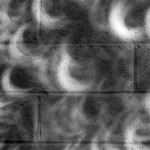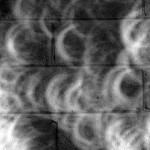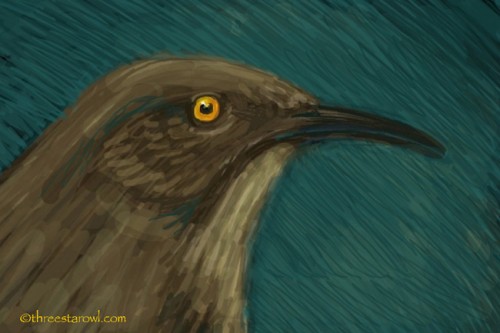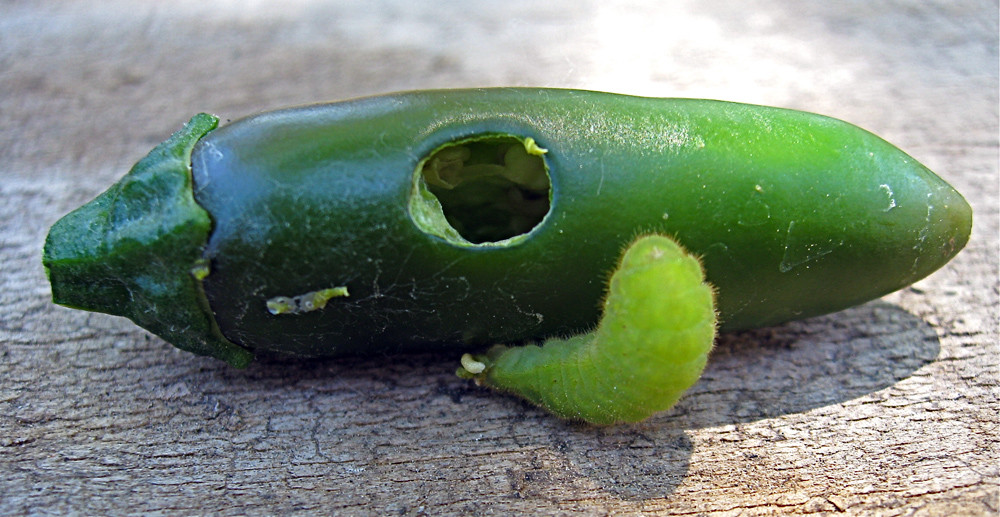Since we aren’t equipped to either observe or photograph solar eclipses directly, E and I took to the yard during Sunday evening’s event to seek indirect eclipse images instead. The classic pinhole method is simple and adequate — poke a small hole in foil or stiff cardboard, and let the sun shine through the hole onto another card, positioned so that a small image of the sun can be seen on the second surface: the bigger the spy-hole, the  farther away the second card needs to be. This works well enough to see with your eyes, but we found the images of the sun were too vague for the clumsy auto-focus mechanisms of digital cameras to gather adequate images. Also, the scale of the card operation is tiny, and so, although interesting (and positively better than the alternatives of not seeing the eclipse or blinding yourself trying) it’s not hugely thrilling.
farther away the second card needs to be. This works well enough to see with your eyes, but we found the images of the sun were too vague for the clumsy auto-focus mechanisms of digital cameras to gather adequate images. Also, the scale of the card operation is tiny, and so, although interesting (and positively better than the alternatives of not seeing the eclipse or blinding yourself trying) it’s not hugely thrilling.
(<< multiple solar eclipses cast onto a house wall through the pine tree canopy)
Fortunately, our yard has an enormous pinhole camera growing in it: the Aleppo pine tree. Its clumped, criss-crossing needles create a fine mesh that, in addition to delightfully sifting raptors out of the wind, also results in a wonderful indirect eclipse-viewing system. The tree’s foliage-mass essentially acts as a large card with innumerable pinholes in it: the pine shadows — as well as the shadows of any other trees with sufficiently small spaces between leaves — become patches of eclipse crescents projected onto the back wall of the house, the block fence, and even the ground where the surface is smooth enough to retain detail. The apertures (the spaces between the trees’ foliage) and the focal plane (the wall, etc) are far enough apart so that the solar crescents are fairly large.
Those solar images can be readily and safely observed and  photographed with any camera, and although not as spectacular as a directly photographed astronomical image of the sun, these sun-shaped light leaks make up for their lack of solitary crispness with the sight of multitudes of bright crescents spangling whatever lies in the umbra of the trees, even E’s ASU tee shirt: Sun Devils for real! >>
photographed with any camera, and although not as spectacular as a directly photographed astronomical image of the sun, these sun-shaped light leaks make up for their lack of solitary crispness with the sight of multitudes of bright crescents spangling whatever lies in the umbra of the trees, even E’s ASU tee shirt: Sun Devils for real! >>
(By the way, trees do this pin-hole sun-image thing all the time, it’s just that the light-leaks are round like the unobstructed sun, so we call it “dappling” and consider it “normal”.)
(Above photos A.Shock)
In the following series of photos (by E.Shock), beginning at the left, you can see the progression of the moon shadow from upper right to lower left across the disc of the sun. In Phoenix, we experienced more than 80% occlusion.





Not a real owl! I photographed this owlmorphic clump of cobwebs and autumn leaves in a tree hollow on Cape Cod in 2007.
 This morning, I found a golden egg, high up in a tree.
This morning, I found a golden egg, high up in a tree.
Nestled into the rough bark of our backyard mesquite, a magical bird had laid a golden egg. This was excellent: what a windfall! — my fortune was secured, if only I could reach it.
But it was too far over my head, so I had to satisfy myself with longing for its golden curves through binoculars.
And guess what, it wasn’t an egg at all, but some type of -quat or other: kum-, or perhaps lo-. Yes, that was what it was: a small orange fruit, probably a loquat since a neighbor has a tree, wedged into somewhere safe by a bird, or maybe a squirrel, to be retrieved later.
Who would do such a thing, hiding a golden treasure in plain sight? The jammer would have to have sufficient strength, beak/jaw gape, toe-grasp, cleverness and agility to handle hauling a small fruit into a tree, and stashing it on a vertical trunk. There are several candidates, but I strongly suspect the Curve-billed thrashers, who have just fledged their ravenous brood and are working incessantly, combing every crevice in the yard to feed their greedy-gaped offspring. These industrious foragers will eat anything, seed, suet, bug, or fruit. And they have an eye for treasure, just as golden as loquats.
but I strongly suspect the Curve-billed thrashers, who have just fledged their ravenous brood and are working incessantly, combing every crevice in the yard to feed their greedy-gaped offspring. These industrious foragers will eat anything, seed, suet, bug, or fruit. And they have an eye for treasure, just as golden as loquats.
(All images A.Shock).
Updated with possible bug ID, see bottom of post:
E sent me a photo he took of this brightly colored centimeter-long bug marching up the stone steps of the Yellow Crane Tower in Wuhan, China. Since there’s not much going on at home here in AZ, except ongoing wrestling with both the machinery and chemistry of a swimming pool that’s picked a very bad time to become unswimmable, I thought I’d shamelessly post vicariously from China instead.
very bad time to become unswimmable, I thought I’d shamelessly post vicariously from China instead.
The shape of the bug’s carapace, coloration and pattern reminded me of something — something Chinese — and, when my brain churned up what it was, I inset an image of it into E‘s bug photo. And, no, “Chinese opera mask bug” is not the insect’s real name. I have no idea about insects, so this guy’s identity is a mystery to me. Any ideas? It’s probably not poisonous — maybe — but it really wants you to think it is! And, it’s on the go: note the blurred-with-lightning-fast-action right-hand mid-leg!
 And, speaking of poisonous, here’s a sight E caught in a public place in Wuhan: 50 gallon drums of Chloroform rusting under a staircase. For when you really, really, need to make sure something’s asleep…
And, speaking of poisonous, here’s a sight E caught in a public place in Wuhan: 50 gallon drums of Chloroform rusting under a staircase. For when you really, really, need to make sure something’s asleep…
(Both photos E.Shock)
Update:
With the help of Google (I searched “red black white hemipteran china”) and the What’s this bug website, I think this guy is the immature form of Lycorma delicatula, which is a Fulgorid leafhopper. They are native to southern China, but have invaded the Korean peninsula, apparently at least in part through lumber imports, where they are considered a pest (see fun Korean video here).
 So what’s new? Underpass art along Hwy 60 at Devil’s Canyon Bridge.
So what’s new? Underpass art along Hwy 60 at Devil’s Canyon Bridge.
Other way to consider this issue: Is the cat amenable to Show Procedure?
Go ahead, click to enlarge. (Photo A or E Shock)
updated:
Wait, I didn’t think I would need to explain that this was found art, not made-by-me art.
 “In the dark was a boojum, you see,” to paraphrase Lewis Carroll.
“In the dark was a boojum, you see,” to paraphrase Lewis Carroll.
The javelinas, bats, and skunks get to see it like this all the time. But before last friday night, I’d never seen a boojum in the moonlight.
Turns out waxing gibbous is a good look for the strange tree.
(Boojum, Fouquieria columnaris, or cirio in Spanish, “candle”. Photo A.Shock, Boyce Thompson Arboretum)
Which feels worse, the hollowed out jalapeño or the worm what done it?
Go ahead; click on it just to make yourself miserable.
 Here are the Famous Fish Rocks, kept fresh with white paint by unknown artists in Trona, California. I admit to disappointment when I found out they were not meant to represent T-rexes rising out of the earth to once again dominate the landscape, but, even if they’re just fish… really big fish… they’re excellent. Each one is the size of a van. I will think of them as Dunkleosteus. The Famous Fish are easy to spot just north of CA State Hwy 178 en route to the Trona Pinnacles.
Here are the Famous Fish Rocks, kept fresh with white paint by unknown artists in Trona, California. I admit to disappointment when I found out they were not meant to represent T-rexes rising out of the earth to once again dominate the landscape, but, even if they’re just fish… really big fish… they’re excellent. Each one is the size of a van. I will think of them as Dunkleosteus. The Famous Fish are easy to spot just north of CA State Hwy 178 en route to the Trona Pinnacles.
<< Fish Rocks (A.Shock)
The Trona Pinnacles were our destination: ancient underwater spring deposits now high and dry in the Mojave Desert. They’re very large-scale versions of the tufa towers on the south shore of Mono Lake, further north, only there’s no water in sight. Predictably, the only creatures there other than ourselves were a traveller in a brightly painted hippy bus, a Rock wren, and a Raven.
traveller in a brightly painted hippy bus, a Rock wren, and a Raven.
The towers are up to 40 feet tall. >>
Perhaps you recognize the setting from Planet of the Apes, or Star Trek V: The Final Frontier?
Surely Shiva abides here.
And also here, at the Trona Community  Methodist Church, which has seen fit to adorn its front entrance with smaller yet equally vigorous tufa deposits. (Click to enlarge.)
Methodist Church, which has seen fit to adorn its front entrance with smaller yet equally vigorous tufa deposits. (Click to enlarge.)
Speaking of reverence gone awry, below is a bonus pop religious image of Shiva. I find this version delightfully goofy: ascetic hermit my butt, there’s Tres Flores in those dreads — this is Shiva El Guapo. It seems to be a portrait of the artist’s well-fed brother in law who wants to be an actor, rather than the standard idealized image of blue-male deity  with the dreamy, stoned I mean introspective expression of the Lord of Eternity. His familiar smile and direct gaze are right out of an AFTRA/SAG headshot — instead of the blessing of Om and the Shiva-linga in his palm, this chap should be flashing us a confident thumbs-up, or making that “call me” gesture next to his Nagraj’s ear.
with the dreamy, stoned I mean introspective expression of the Lord of Eternity. His familiar smile and direct gaze are right out of an AFTRA/SAG headshot — instead of the blessing of Om and the Shiva-linga in his palm, this chap should be flashing us a confident thumbs-up, or making that “call me” gesture next to his Nagraj’s ear.
Sometimes when you say “Goats in Trees,” people say, “No way.”
Way.
Here are goats in trees.
(Photo by E.Shock; Oman, 2010)
 farther away the second card needs to be. This works well enough to see with your eyes, but we found the images of the sun were too vague for the clumsy auto-focus mechanisms of digital cameras to gather adequate images. Also, the scale of the card operation is tiny, and so, although interesting (and positively better than the alternatives of not seeing the eclipse or blinding yourself trying) it’s not hugely thrilling.
farther away the second card needs to be. This works well enough to see with your eyes, but we found the images of the sun were too vague for the clumsy auto-focus mechanisms of digital cameras to gather adequate images. Also, the scale of the card operation is tiny, and so, although interesting (and positively better than the alternatives of not seeing the eclipse or blinding yourself trying) it’s not hugely thrilling. photographed with any camera, and although not as spectacular as a directly photographed astronomical image of the sun, these sun-shaped light leaks make up for their lack of solitary crispness with the sight of multitudes of bright crescents spangling whatever lies in the umbra of the trees, even E’s ASU tee shirt: Sun Devils for real! >>
photographed with any camera, and although not as spectacular as a directly photographed astronomical image of the sun, these sun-shaped light leaks make up for their lack of solitary crispness with the sight of multitudes of bright crescents spangling whatever lies in the umbra of the trees, even E’s ASU tee shirt: Sun Devils for real! >>

















